Micro Nymphing
Not long ago, I received an email in which a customer mentioned "micro nymphing." Reading it was like a jolt. I have fished for micros with tiny nymphs more than a few times and for more than a few years, but I thought of it as fly fishing for micro fish. I never thought of it in the way he described it in his email.
If you do an internet search on "micro nymphing" you'll get a couple hits describing fishing micro nymphs for trout. That is not what he described. Not at all.
Most of his fishing had been Euro-nymphing or tight line nymphing for trout. He lives too far away from a trout stream to fish as often as he'd like so he started micro fishing in the small local streams.
Although his micro fishing started out as just a way to go fishing more frequently and closer to home, he realized that it had another significant benefit. It made him a better Euro nympher!
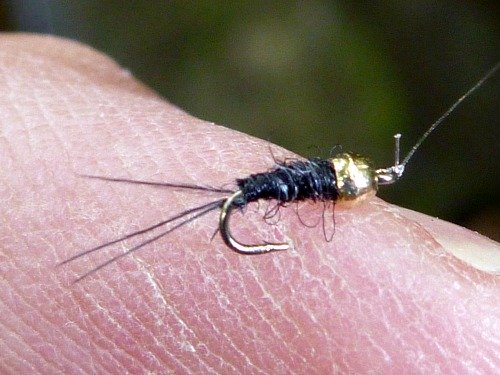 Size 26 is a good size for the smallest micros
Size 26 is a good size for the smallest microsHe wrote that when micro fishing, he uses the same techniques he uses on a trout stream, but he does it with size 26 flies and a tenkara rod. (I think he uses a Kurenai HM30R which is actually a seiryu rod - and is better suited to micro nymphing than most tenkara rods).
His view is that there is no better way to sharpen Euro nymphing or tight line nymphing skills than by getting good drifts with a size 26 nymph and detecting subtle strikes from micros. In his words, "I bet when the tight liners figure out how much better it makes their normal Euro nymphing, most serious guys will flock to it."
Most of my own fishing is not tight line nymphing or Euro nymphing. However, I can certainly understand why he came to that conclusion. I have had a few experiences that really highlight the sensitivity required to fish micro nymphs for micro fish.
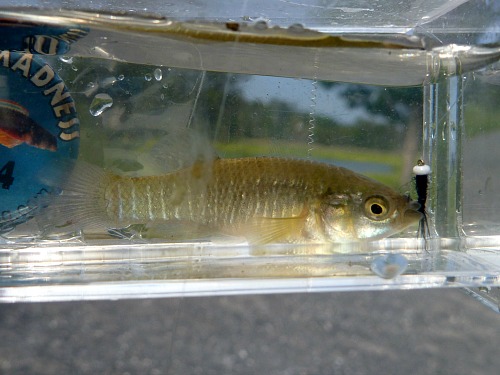 White bead helps when sight fishing
White bead helps when sight fishingPerhaps the most dramatic was on a day I was fishing a salt marsh with Coach. We were both fishing the exact same fly, a black Killer Bugger with a white glass bead head. He was fishing his "go to" Suntech Kurenai HM39R (12 pennies) with a size 3 Sunline tenkara line. I was using a Nissin SP 390 (8 pennies - discontinued by Nissin) casting a line the diameter of 6X tippet with a single Dinsmore size 10 shot to provide the weight needed to make the cast. It was one of the few times I soundly out-fished Coach.
The Mummichogs we were fishing for were too far away to see the white bead head in the water (although that's why we had chosen to fish them), and they were too small for Coach's size 3 line to register the strikes very often. They were plenty large enough to cause my 6X line to hesitate or twitch, though. The 6X was a hi-vis Ayu line, but hi-vis 6X is an oxymoron. The line is too thin to see very well no matter what color it is. On that day, though, the light was good and I was able to see the hits.
Fishing with a line that is light enough to register the take of a micro is key. They do not smash your fly. To call the strike a "tick" is almost an exaggeration. It's not quite imperceptible, but it is extremely subtle. The lighter your line, the easier it is for a micro to make it twitch.
Use the lightest line you can cast.
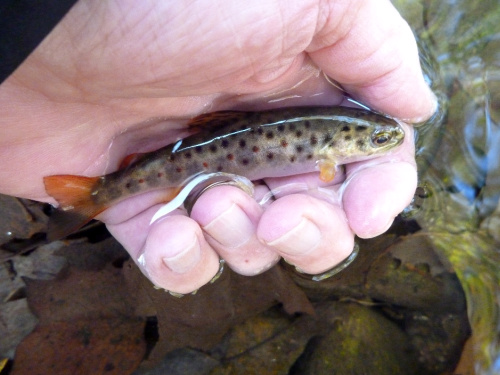 One of the few tiny fish I was able to hook
One of the few tiny fish I was able to hookEarlier this fall I was fishing a stream in which the water was very low and very clear. I was fishing a light colored wet fly and towards the end of the drift I could see the fly clearly. The stream has excellent natural reproduction and there are lots of small trout. I was surprised how often I saw the fly lurch an inch or so to the side. That had to have been caused by young of the year trout, which were large enough to hit the fly, but too small to hook very often with the size 12 I was fishing.
When fishing either wet flies or nymphs, I am sure we get many more hits than we either see or feel. Fishing with a very light line, a very sensitive rod and flies small enough for micros to take has to help condition the senses and the reflexes.
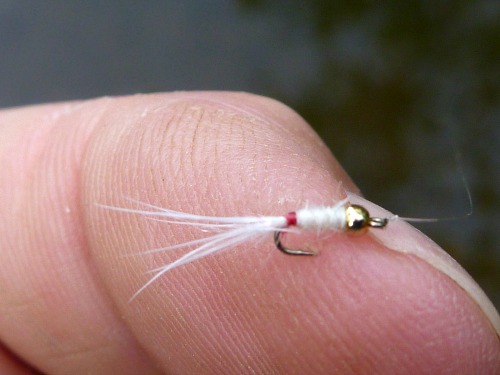 Gold bead head white Killer Bugger
Gold bead head white Killer BuggerSight fishing is more easily done when fishing for micros than for trout, largely because the water is often much shallower. When fishing close by and in shallow, clear water, I have found it to be very useful to use a white fly.
Micros don't seem to care what color the fly is. The gold bead on a a black Killer Bugger does make the fly somewhat visible, but a white fly really stands out against a dark stream bottom. You often can't see the fish, which have excellent natural camouflage, but you can often see the white fly just disappear. It disappears into a fish's mouth!
That said, I do have one customer whose "go to" fly when fishing for trout is a white killer bugger because he can often see the take.
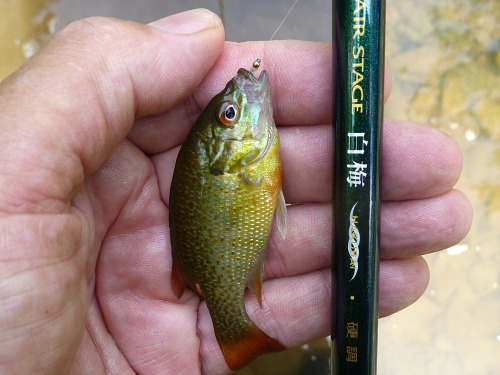 Redbreast sunfish caught with white bead head Killer Bugger
Redbreast sunfish caught with white bead head Killer BuggerDepending on where you are fishing, your target species may be small sunfish. If not, though, and if there are sunfish in your waters, you might not be able to get past them to reach your target. Small sunfish are voracious. If they're there, you'll catch them micro nymphing (whether you want to or not).
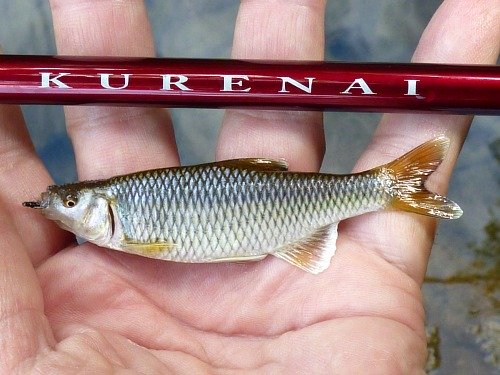 Unweighted size 26 black Killer Bugger
Unweighted size 26 black Killer BuggerMost of the micro nymphing I have done has been with a bead head Killer Bugger. The bead has almost always been gold tungsten. As mentioned above, the gold helps in watching the fly.
The tungsten bead adds just enough weight to help cast a very light line and very light tippet. It also helps get the nymph a little deeper. For that matter, with a size 26 fly, sometimes the bead is needed just to break the surface tension!
I have fished with unweighted Killer Buggers, though, and have caught fish with them.
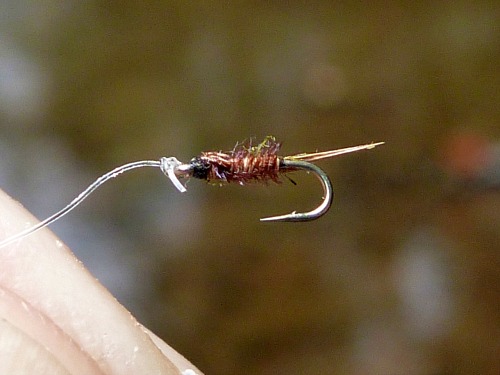 Size 26 pheasant tail nymph. (I had run out of thinner tippet.)
Size 26 pheasant tail nymph. (I had run out of thinner tippet.)I have also caught fish with unweighted Pheasant Tail Nymphs. A size 26 Pheasant Tail Nymph is harder to tie than a size 26 Killer Bugger, though, and a Killer Bugger has been plenty effective.
If you love tying flies, by all means, tie size 26 Pheasant Tail Nymphs. If you just love to catch fish, though, tie Killer Buggers. Of course, other simple patterns like an Al's Rat or Zebra Midge work also. I have not found micros to be particularly picky, so there's no need to carry a box full of different patterns.
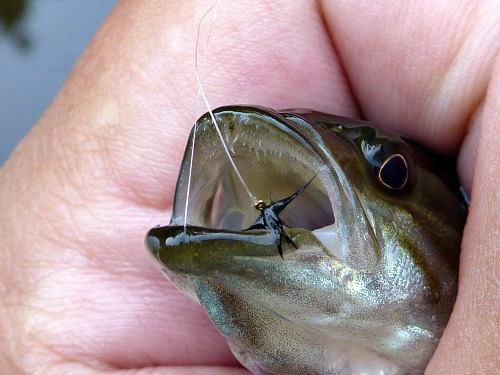 Smallmouth bass, size 32 Stewart Black Spider
Smallmouth bass, size 32 Stewart Black SpiderEuro nymphers will often fish a pair of nymphs. I don't think I have ever done that while fishing for micros. The closest thing I have tried is once fishing a small unweighted Stewart Black Spider on a dropper and a bead head Killer Bugger as the point fly. Both flies caught fish, although never on the same cast.
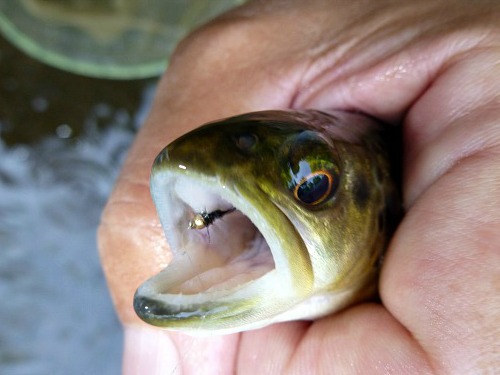 Small trout, very small fly
Small trout, very small flyWhen fishing for trout, I have caught fish with a size 26 bead head Killer Bugger, but only in a small stream at a low water level. I have also fished a couple streams where the 26 didn't draw strikes but a 20 did. My guess is that the 26 just didn't get deep enough.
For many micros, you don't need to go all the way to a size 26 or smaller. Coach and I have caught more fish and more species with a size 20. For very small micros, you would need the 26.
If you are fishing for micro fish, use micro flies.
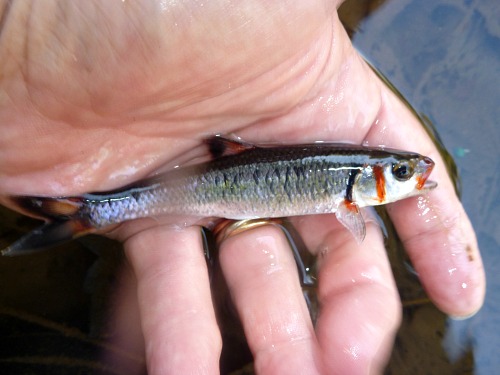 Warpaint shiner
Warpaint shinerMost of the fish I have caught with micro nymphs have been caught wth seiryu rods. Most but not all. On one trip to North Carolina for a Tenkara Jam we had all fanned out to fish one particular river. I learned that a small tributary had a good population of Warpaint Shiners, a species I had never caught. I didn't have a micro rod or even a seiryu rod with me, so I used my TenkaraBum 40 with my lightest line and smallest fly and was able to catch a few.
Whereas a Suntech Kurenai II AR30F might be a more obvious choice for micro nymphing, one advantage of a rod like the TenkaraBum 40 is that you could use the exact same rod and line when you are Euro nymphing. That way, the "sensitivity training" would be directly applicable to the "real" world.
But you know, even if you're not a dedicated Euro nympher, micro nymphing can improve your senses and your reflexes. The strikes really are subtle. And if nothing else, it will help to mitigate overly aggressive hooksets. You definitely do not want to spend your day searching the weeds behind you for the little guys you launched over your shoulder.
More than all that, though, I think you'll find it to be an enjoyable challenge. Plus, of course, micros are everywhere.
TenkaraBum Home > Midges & Micros > Micro Nymphing
“The bitterness of poor quality remains long after the sweetness of low price is forgotten” - Benjamin Franklin
"Be sure in casting, that your fly fall first into the water, for if the line fall first, it scares or frightens the fish..." -
Col. Robert Venables 1662
As age slows my pace, I will become more like the heron.
We've all had situations where seriously chewed up flies kept catching fish after fish after fish. It is no sin to tie flies that come off the vise looking seriously chewed up.
Warning:
The hooks are sharp.
The coffee's hot.
The fish are slippery when wet.
Beware of the Dogma
Seriously, all the hooks sold on TenkaraBum.com, whether packaged as loose hooks or incorporated into flies, are sharp - or as Daiichi says on their hook packages, Dangerously Sharp. Some have barbs, which make removal from skin, eyes or clothing difficult. Wear eye protection. Wear a broad-brimmed hat. If you fish with or around children, bend down all hook barbs and make sure the children wear eye protection and broad-brimmed hats. Be aware of your back cast so no one gets hooked.
Also, all the rods sold on TenkaraBum.com will conduct electricity. Do not, under any circumstances, fish during a thunder storm. Consider any fishing rod to be a lightning rod! Fishing rods can and do get hit by lightning!
What's in stock?
Kurenai II AR 30F
Kurenai II AR 33F
Kurenai II AR 39F
TenkaraBum 33
TenkaraBum 36
TenkaraBum 40
Nissin Oni Tenkara Line
Coming Soon
January
Furaibo TF39
Furaibo TF39TA
Latest Pages
If you enjoy spin fishing or baitcasting please visit my sister site Finesse-Fishing.com.


